(PCC) Program on Chinese Cities – Thoughts on Overseas Travels Series
Authors: Jie Ren,
PhD candidate at the College of Architecture and Urban Planning, Tongji University;
Joint Ph.D. student in the Department of City and Regional Planning, University of North Carolina at Chapel Hill. renjie_cathy@163.com
The American Tobacco Campus (ATC), situated in Durham, North Carolina, USA, covers an area of 16 acres (approximately 6.47 hectares) with a built-up space of about 1 million square feet (approximately 92,903 square meters). This site is steeped in the rich history of tobacco industry development in North Carolina from the 1870s to the 1980s, representing a significant piece of Durham’s industrial heritage. In 2000, it was listed on the National Register of Historic Places. In 2002, with the support of the Durham city government, Capitol Broadcasting Company launched a project to revive and redevelop the ATC. The project was highly successful, not only transforming the previously abandoned industrial site into a new hallmark for the city but also significantly promoting local urban renewal and economic recovery.
1. Historical Context of the American Tobacco Campus
The American Tobacco Campus was formerly the site of the American Tobacco Company, once the world’s largest tobacco firm, which, at its peak, controlled 90% of the U.S. tobacco market. Its “Lucky Strike” brand was widely known. Historically, the company played a crucial role in Durham’s economic development as the city’s leading employer and key enterprise. However, as public health concerns over tobacco usage increased, the industry began to decline. The American Tobacco Company shut down its Durham factory in 1987, relocating to Reidsville. Subsequently, the area around the ATC saw a gradual decline in commercial and residential facilities. Over the following decade, the site was largely unused, occasionally serving as a tactical training ground for local police.
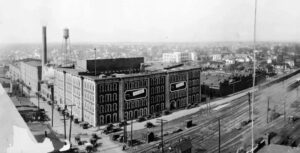
2. Implementation and Outcomes of the ATC Redevelopment Project
The rapid development of Durham City after the Civil War can largely be attributed to the booming tobacco industry, making the ATC a valuable piece of industrial heritage. To protect and restore these historically significant buildings, Capitol Broadcasting Company purchased the ATC in April 2002 and began restoration efforts in 2003.
The redevelopment project unfolded in three phases. The first phase (2003–2004) included major renovations such as the restoration of the iconic “Lucky Strike” brick chimney and the Fowler, Strickland, Reed, and Washington buildings; construction of two new parking lots; and the introduction of a water feature (Bull River) to enhance the site’s appeal. In May 2005, the second phase focused on renovating the remaining buildings in the northern part of the site. Both phases preserved the original brick facades while updating the functions of the buildings to accommodate offices, dining, residential, entertainment, and event spaces. The final phase involved the construction of the Durham Performing Arts Center on the eastern side of the campus, which officially opened on November 30, 2008, and became one of the most attended arts centers in the U.S. by 2011.
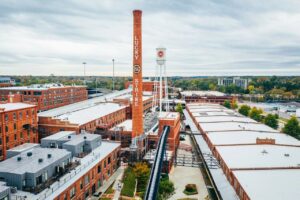
The revitalization of the ATC played a significant role in Durham’s economic resurgence. Research indicates that between 1987 and 2003, during the 17 years the American Tobacco Company facilities were idle, downtown Durham saw less than one major development project per year. However, in the five years following the completion of the first phase of the project (2005–2009), the city completed 16 major projects, averaging over three major projects annually. Additionally, compared to 2002–2004, Durham’s real estate sales volume increased by 62%, average sales price by 115%, and total sales amount by 248% between 2005 and 2007.
3. Renewal Strategies for the American Tobacco Campus
- Respect and Preservation of Historical Elements: The renovation preserved iconic features such as the red brick chimneys and water towers, as well as many buildings’ brick walls and wooden beams, thus maintaining the original character of the industrial heritage. Artworks and murals featuring industrial elements were also included to document the unique history and culture of the site.
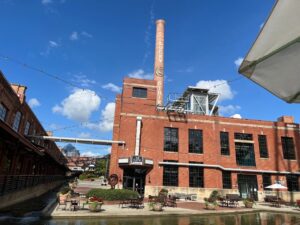
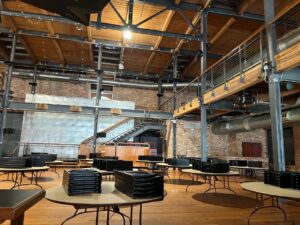
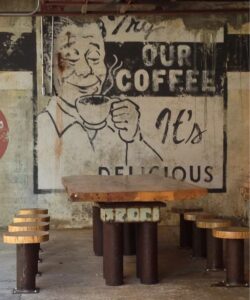
- Integration of Diverse Spaces and Functions: The campus redevelopment placed a strong emphasis on mixed-use functionality, including a significant amount of Grade-A office space, diverse dining and entertainment options (cinemas, art centers), event spaces (indoor weddings, conference facilities, and outdoor event spaces), sports facilities (basketball and baseball courts), and residential areas. This integration of varied spaces and functions turned the American Tobacco Campus into a vibrant community, attracting well-known companies such as GlaxoSmithKline (GSK) and Burt’s Bees, as well as numerous startups. Currently, the campus hosts 85 businesses of various sizes, providing over 4,000 jobs.
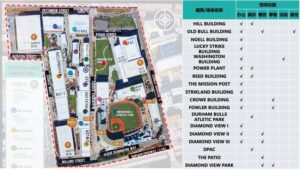
- Provision of Comfortable Public Spaces: The design included a variety of beautiful and comfortable public spaces and amenities, such as green areas, fountains, and public seating, offering a diverse range of work and leisure environments for office workers and attracting many visitors.
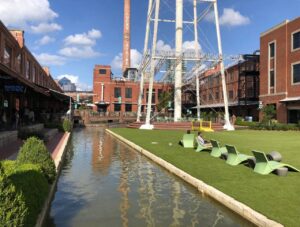
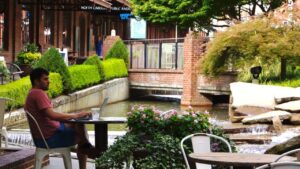
4. Success Factors of the ATC Redevelopment Project
The success of the ATC redevelopment project, following unsuccessful attempts by ABD Associate and Blue Devil Ventures due to a lack of public support and investors, was largely due to tax incentive policies and support from the Durham city government and early tenants.
- North Carolina Historic Preservation Tax Credits: In 1997, the North Carolina legislature passed a historic restoration tax credit bill, increasing the tax credit for income-producing historic restorations from 5% to 20% and introducing a 30% tax credit for non-income-producing renovation costs. This policy was key to Capitol Broadcasting Company’s decision to commit to the ATC redevelopment.
- New Markets Tax Credit Program: In 2000, the U.S. Congress established the New Market Tax Credit Program (NMTC Program) to stimulate private investment in low-income community economic development projects by offering tax credits to investors. Financing obtained through the NMTC Program played a crucial role in the American Tobacco Company’s redevelopment project, accounting for approximately 53% and 33% of the total costs for the first and second phases, respectively.
- Durham City’s Financial Incentive Policies: Since most major reconstruction or new development projects in the U.S. post-1990 have involved the development of large parking lots due to the country’s extensive highway system and reliance on automobiles, the Durham city government raised $43.2 million for the construction of two parking lots within the campus by increasing property tax rates. This funding was instrumental in attracting businesses to the ATC and facilitating visitor access.
- Early Tenant Commitments: Durham, home to Duke University, saw the university as a major supporter of the ATC redevelopment project. During the project’s planning phase, Duke University committed to leasing 100,000 square feet of office space, and it remains a significant tenant to this day, with offices in several buildings within the campus. Additionally, companies like GlaxoSmithKline were among the early tenants, providing confidence and momentum for the project’s successful launch.
Note: Images 1–2, 5 are sourced from https://www.hipstorical.com/american-tobacco-campus/; images 3–4, 7–8 were taken by the author.
